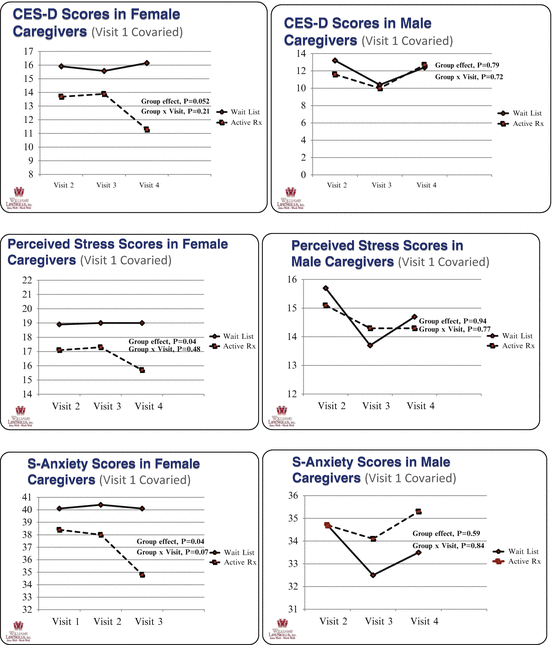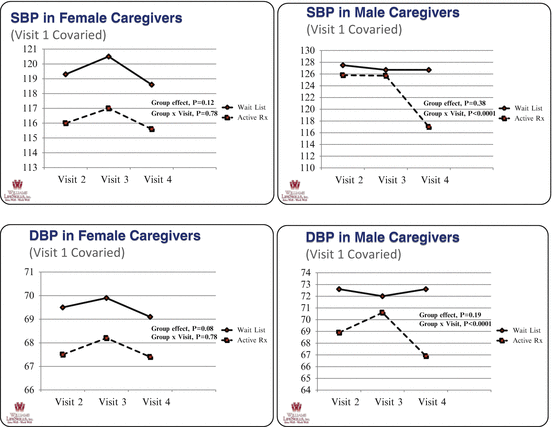1. Logkeeping
2. Think before you act to decide between action and deflection
3. Deflection
4. Problem solving
5. Assertion
6. Saying no
7. Speaking
8. Listening
9. Empathy
10. Positives over negatives: aligning with goals
The other element of our intervention was 5 telephone calls from a LifeSkills facilitator with specific training in application of the 10 LifeSkills to situations encountered by caregivers. Each of these contacts was of about 30 min duration and held after the caregiver had watched two segments of the video and read the accompanying workbook. The Williams LifeSkills caller had a coaching handbook designed for this study.
As we recently reported in the study already cited (1), LifeSkills Video for caregivers had a beneficial effect on three primary outcomes: significant decreases in depressive symptoms, and perceived stress, with a trend for trait anxiety. There were no significant effects for the primary outcomes of state anxiety and state and trait anger. Secondary outcomes of hostility, disruptive sleep, and caregiver self-efficacy also showed no significant effects. As regards physiological outcomes, caregivers who received LifeSkills training showed significantly larger decreases in systolic blood pressure and diastolic blood pressure compared to caregivers in the wait list control group. In sum, three of five primary psychological outcome measures and both primary biological stress markers were lower (depressive symptoms, trait anxiety, perceived stress, DBP) across the 6-month follow-up period or showed a larger decrease (SBP and DBP) across the follow-up period in caregivers assigned to the Video-based Coping Skills arm of the trial than levels observed in the Wait List control group. In contrast to prior successful interventions in caregivers that were continuously delivered, in some cases, over periods of years (34), these improvements were observed immediately at the conclusion of the 5-week training period and were sustained, with no further reinforcement, over the 5-month follow-up period after the 5 weeks of training. This suggests that caregivers in the Video/Workbook/Telephone Coaching arm continued to use the skills they had learned.
Caregiver Data Reexamined for Possible Gender Differences
When invited to participate in the festschrift for Dr. Kristina Orth-Gomer, we faced the initial concern that all of our prior research had focused on LifeSkills interventions that targeted categories of people—those with psychosocial distress, high school students, incarcerated juvenile offenders (ongoing work), hospital workers with previously untreated elevated blood pressure, medical students (ongoing work), ministers (ongoing work) and caregivers—with study groups including both males and females. Given that Dr. Orth-Gomer’s outstanding contributions are to our understanding the impact of stress on heart disease in women and their testing of behavioral interventions to reduce that impact, we decided to reexamine the data from our recent caregiver study (1), to see if the benefits of LifeSkills training for caregivers were different in men and women. Would the results we found still hold? And would the categories of improvement be the same for women and men?
To answer these questions the study statistician (JDL) analyzed the data separately for 46 men and 44 women, reran the analysis used for the original report, using the same regression model to test effects of treatment group (Active Rx with LifeSkills Video plus telephone coaching vs. Wait List control), visit (2, 3, and 4:7 weeks, 3 months and 6 months after end of training) and their interaction, co-varying the pretreatment visit 1 levels, on the same psychological and physiological outcomes that had been significantly improved by LifeSkills training in our original report.
As shown in Fig. 13.1, among women, the Center for Epidemiologic Studies-Depression Scale (CES-D), Perceived Stress Scale (PSS), and State Anxiety Scale scores were significantly lower across the three follow-up visits in caregivers who received LifeSkills training than those in the Wait List control group. In marked contrast, among men, there were no significant, or even trends toward, significant effects of LifeSkills training on these three psychological outcomes. As shown in Fig. 13.2, however, there were no significant effects of LifeSkills training on Systolic Blood Pressure (SBP) and Diastolic Blood Pressure (DBP) among women, but in men LifeSkills training produced robust decreases in SBP and DBP that became larger across the 6-month follow-up period.



Fig. 13.1
Effects of Williams LifeSkills training on depressive symptoms, perceived stress, and state anxiety in male and female caregivers

Fig. 13.2
Effects of Williams LifeSkills training on systolic and diastolic blood pressure in male and female caregivers
Discussion
Both women and men caregivers can be helped by Williams LifeSkills Training. However, the benefits appear to be different. Men lower their blood pressure. Women reduce their depression, perceived stress, and anxiety levels.
We can only speculate on the reasons for these differences. The blood pressure levels were objectively measured using an automated BP monitor, and men showed reduced levels that increased across the 6-month follow-up period, but women did not. Since the psychological outcomes were assessed by self-report, it could be that women’s higher awareness of their feelings and state of mind could have made them more likely to observe changes in these domains.
The current findings may have implications for our understanding of the mechanisms responsible for the reduced morbidity/mortality among patients receiving group-based cognitive behavioral stress management training similar to LifeSkills in two recently reported clinical trials in CHD patients (Orth-Gomér et al. 2009; Gidron et al. 1999; Gulliksson et al. 2011). While the SWITCHD trial (Orth-Gomér et al. 2009) only included women, the SUPRIM trial (Gulliksson et al 2011) included both men and women. It is tempting to speculate that in the SUPRIM trial the improved prognosis was mediated by decreased psychological distress in the women but by decreased blood pressure in the men. Decreased blood pressure levels, as well as decreased blood pressure reactivity to acute mental stress, has been observed in male post-bypass surgery patients who received LifeSkills training (Bishop et al. 2005).
At present, we can say that Williams LifeSkills training for caregivers does have benefits for both sexes, but the nature of these benefits differs by sex. To encourage participation in future trainings, the psychological benefits may be better to emphasize with women, the physical benefits with men. Also, during training, telephone coaches may want to be on the lookout whether different emphases work better with one sex or the other. Further research will be required to determine whether these differences between the sexes in benefits of cognitive behavioral training to cope more effectively with stress are playing a role in improved clinical prognosis following such training in various patient groups.
References
Aschbacher, K., Mills, P. J., von Kanel, R., Hong, S., Mausbach, B. T., Roepke, S. K., … , Grant, I. (2008). Effects of depressive and anxious symptoms on norepinephrine and platelet P-selectin responses to acute psychological stress among elderly caregivers. Brain, Behavior, and Immunity, 22, 493–502.
Barnes, V. A., Johnson, M. H., Williams, R. B., & Williams, V. P. (2012). Impact of Williams LifeSkills® training on anger, anxiety, and ambulatory blood pressure in adolescents. Translational Behavioral Medicine, 2(4), 401–410.PubMedCentralPubMedCrossRef
Belle, S. H., Burgio, L., Burns, R., Coon, D., Czaja, S. J., Gallagher-Thompson, D., … , Resources for Enhancing Alzheimer’s Caregiver Health (REACH) II Investigators. (2006). Enhancing the quality of life of dementia caregivers from different ethnic or racial groups—A randomized, controlled trial. Annals of Internal Medicine, 145, 727–738.
Brummett, B. H., Krystal, A. D., Ashley-Koch, A., Kuhn, C., Züchner, S., Siegler, I. C., … , Williams, R. B. (2007). Sleep quality varies as a function of 5-HTTLPR genotype and stress. Psychosomatic Medicine, 69, 621–624.
Christakis, N. A., & Allison, P. D. (2006). Mortality after the hospitalization of a spouse. The New England Journal of Medicine, 354, 719–730.PubMedCrossRef
< div class='tao-gold-member'>
Only gold members can continue reading. Log In or Register to continue
Stay updated, free articles. Join our Telegram channel

Full access? Get Clinical Tree


